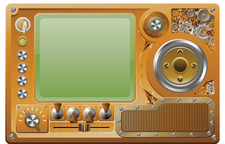Datamancer offers sturdiness with a Steampunk aesthetic
Hands-On

© Lead Image © Christos Georghiou, 123RF.com
Hand-crafted keyboards, computers, and accessories from the imagination of a retro-Victorian artist.
If your home or office is decorated in rich hardwoods, why not have matching computer hardware, rather than futuristic black plastic? – Richard R. Nagy
Richard R. Nagy of Datamancer Enterprises [1] has spent the past few years answering his own question with a line of hand-made keyboards and other computer hardware, much of it with a Victorian-retro or Steampunk aesthetic. His explorations have given him a small but enthusiastic cult following among artists, gamers, and developers.
Nagy has no formal art training. However, he says, "I've always enjoyed drawing, and when I was young I read a lot of fantasy novels and read comic books, copying the art styles of the comic book artists I admired like Todd McFarlane and Jim Lee." At the same time, "I was also very mechanically inclined, and used to disassemble all of my toys and build new ones from the parts, much to the dismay of my mother. I would design custom toys using simple circuits with batteries, switches, motors, and LEDs."
[...]
Buy this article as PDF
(incl. VAT)
Buy Linux Magazine
Subscribe to our Linux Newsletters
Find Linux and Open Source Jobs
Subscribe to our ADMIN Newsletters
Support Our Work
Linux Magazine content is made possible with support from readers like you. Please consider contributing when you’ve found an article to be beneficial.

News
-
Manjaro 26.0 Primary Desktop Environments Default to Wayland
If you want to stick with X.Org, you'll be limited to the desktop environments you can choose.
-
Mozilla Plans to AI-ify Firefox
With a new CEO in control, Mozilla is doubling down on a strategy of trust, all the while leaning into AI.
-
Gnome Says No to AI-Generated Extensions
If you're a developer wanting to create a new Gnome extension, you'd best set aside that AI code generator, because the extension team will have none of that.
-
Parrot OS Switches to KDE Plasma Desktop
Yet another distro is making the move to the KDE Plasma desktop.
-
TUXEDO Announces Gemini 17
TUXEDO Computers has released the fourth generation of its Gemini laptop with plenty of updates.
-
Two New Distros Adopt Enlightenment
MX Moksha and AV Linux 25 join ranks with Bodhi Linux and embrace the Enlightenment desktop.
-
Solus Linux 4.8 Removes Python 2
Solus Linux 4.8 has been released with the latest Linux kernel, updated desktops, and a key removal.
-
Zorin OS 18 Hits over a Million Downloads
If you doubt Linux isn't gaining popularity, you only have to look at Zorin OS's download numbers.
-
TUXEDO Computers Scraps Snapdragon X1E-Based Laptop
Due to issues with a Snapdragon CPU, TUXEDO Computers has cancelled its plans to release a laptop based on this elite hardware.
-
Debian Unleashes Debian Libre Live
Debian Libre Live keeps your machine free of proprietary software.

